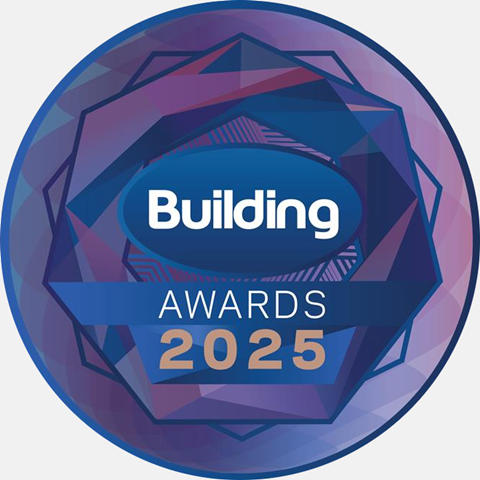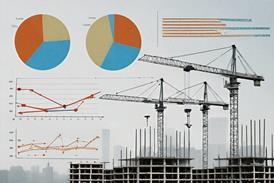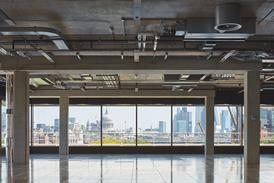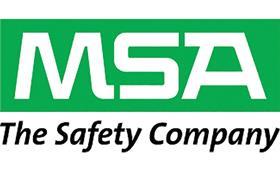
Sponsored by MSA Safety, this CPD explores best practice for safe access and egress when working at height, highlighting key legislation, designer responsibilities and the role of informed decision-making in improving worker safety
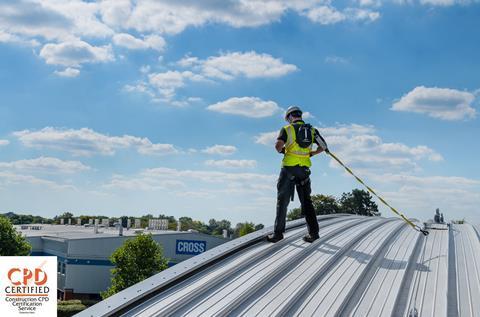
Falls from height remain the leading cause of fatal workplace injuries in the UK. According to the Health and Safety Executive (HSE), 50 workers lost their lives due to falls from height in 2023/24, accounting for 36% of all work-related fatalities. While specific data on accidents during access and egress is limited, helping to create safe entry and exit points can help prevent such tragedies.
In the built environment sector, safe access and egress are often overlooked in the design and planning stages, yet they are integral components of a comprehensive approach to fall protection. Poorly designed entry and exit routes can create significant hazards, particularly when workers are required to use ladders or scaffolding for access to high-level work areas. Addressing these risks from the outset helps to ensure that safety is embedded into the project rather than being treated as an afterthought.
This CPD explores best practice for safe access and egress when working at height, focusing on the responsibilities of principal designers. It will outline key legislation and compliance requirements related to means of approach and departure while highlighting how informed design decisions can improve worker safety. By fostering a stronger safety culture across the built environment sector, the industry can drive meaningful improvements for height safety in the UK.
Objectives
- Understand the importance of safe access and egress in the context of fall protection.
- Identify key industry standards and regulations relevant to working at height.
- Recognise the limitations of traditional hoop ladders and the benefits of alternative ladders.
- Gain awareness of best practices and real-world examples of integrated safety design.
The importance of designing in safety
Designing in safe access, maintenance and egress is a fundamental responsibility for architects and principal designers. Under the Work at Height Regulations 2005 and the Construction (Design and Management) Regulations 2015, designers must proactively eliminate or mitigate heightrelated risks from the outset. This is also an opportunity for designers to embed safety into the very fabric of building design.
Regulatory updates have further reinforced the role of principal designers in shaping safer work environments. Under the Building Safety Act 2022 (BSA), principal designers in higher-risk buildings must actively manage safety throughout a project’s lifecycle, helping to achieve compliance with the Building Regulations and the BSA’s requirement for a golden thread of information. This shift places greater accountability on designers to consider long-term risks, including ensuring safe access for maintenance and the provision of suitable fall protection.
Additionally, updates to CDM regulations emphasise that principal designers must co‑ordinate safety measures from the earliest design stages, so that foreseeable risks – such as those related to access and egress – are adequately addressed. By prioritising robust safety strategies, principal designers play an important role in reducing accidents and enhancing industry-wide safety standards.
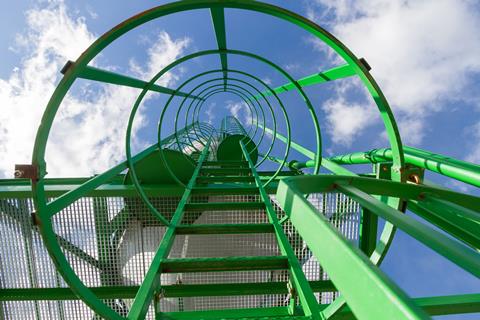
Risk assessment and hazard identification
Risk assessments and hazard identification should be a core part of any project involving work at height. Conducting a thorough risk assessment early in the design phase allows designers, contractors and employers to anticipate potential risks and implement safety measures before work begins. A risk assessment should seek to identify potential hazards related to access and egress, including evaluating stairways, scaffolding, elevated platforms, or any other systems that workers will use to reach elevated work areas. The goal is to identify all risks, including those that may not be immediately apparent, and to design out or mitigate these risks where possible.
Various methods can be employed for hazard identification, including task-based risk assessments, safety audits and consulting with experienced safety experts. Risk assessments should consider the nature of the work, the environment and the type of access being used. Consideration should also be given to factors such as weather conditions, fatigue and worker competency when assessing risk.
The risk assessment process can benefit from including a broad range of stakeholders, such as architects, contractors, safety engineers and workers using the access systems. By involving those who have hands-on experience with access equipment, a more comprehensive understanding of potential hazards can be gained, leading to more effective safety solutions.
Risk assessments should be well documented and integrated into the project plan to meet industry best practice. Designers should regularly review and update risk assessments as projects evolve, particularly when there are changes to the design, equipment or work practices.
Understanding ladder access risks
Industry best practice highlights the importance of reducing risks through design, emphasising safer means of access and maintenance. Many falls from height occur during access and egress. In the food and drink industries alone, an analysis of 150 falls over three years found that 40% involved ladders, underscoring the importance of addressing ladder safety at every design stage.
Ladders are commonly used for access in many industries, but they pose specific risks, particularly when the ladder design does not adequately consider fall protection. While industry regulations currently allow for hoop ladders, they remain a point of contention. The HSE has raised concerns about their safety, stating that there is no evidence that hoops (also known as cages) on ladders provide complete fall arrest capability.
Industry standards and regulations, such as BS 4211:2005 (which sets design standards for fixed ladders) and BS EN 353 (covering fall protection systems used on ladders), provide guidelines on ladder safety. However, these standards represent the minimum requirements, and many designers and safety professionals are paying greater attention to eliminating potential risks through better design and alternative access solutions.
The main challenge with hoop ladders lies in their inadequate fall protection. While they may offer some support, they do not have the capacity to prevent falls in the same way as modern, more advanced systems. As such, designers may wish to go beyond minimum compliance and prioritise safer, more effective means of access in their plans. This includes considering alternatives like ladder safety devices or permanent fall protection systems that offer better protection for workers.
![]()
Best practice solutions for ladder safety
Several best practice solutions are available to improve safety of ladder access systems:
- Personal fall protection systems: These systems, such as cable-based or rail systems, can be integrated into ladder designs to provide continuous fall protection. By attaching the worker’s harness to a fixed point along the ladder, they secure the worker while ascending or descending, significantly reducing the risk of a fall.
- Self-retracting lifelines (SRLs): SRLs are increasingly popular in ladder safety because they allow for a greater range of movement while also providing fall protection. The lifeline is designed to retract in the event of a fall, reducing the distance a worker could fall. SRLs are ideal for workers who need mobility and safety when using ladders for access.
- Manual double-hook ropes: Another option for improving safety on ladders is the use of manual double-hook ropes. These systems allow workers to secure themselves while climbing, with the ability to easily adjust the rope as they ascend. Though more manual in nature, these systems are effective in preventing falls when properly used.
While these safety systems offer increased protection, they are most effective when integrated into the design at the outset of a project. However, a culture shift is equally necessary. The industry must move from a reactive, compliance-only approach to a proactive, preventative approach to fall protection.
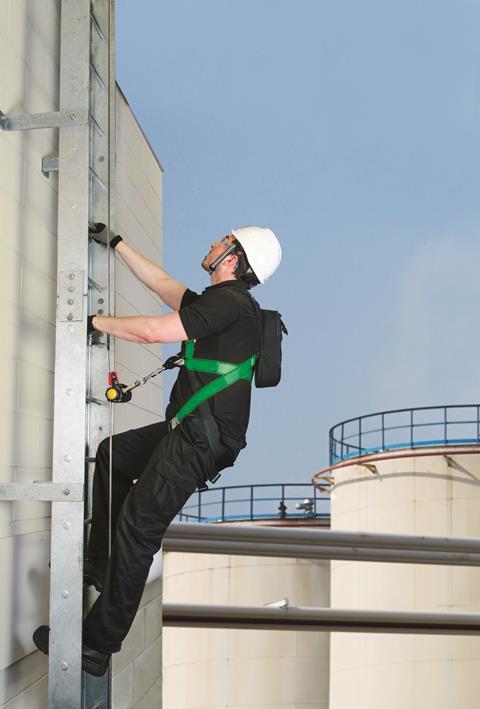
Training and competence of workers
Even with the safest designs in place, proper training is essential for maintaining a secure working environment when accessing heights. Workers should understand the hazards associated with working at height and the equipment that they are using.
Proper training should include the safe use of access equipment, such as scaffolding, fall protection systems and alternative means of safe access (such as fixed stairways and platforms). This training should cover proper usage techniques, potential hazards and the correct set-up and inspection procedures. Workers should also be educated about the limitations of equipment such as hoop ladders, the necessity for fall protection and how to recognise the signs of equipment wear or failure.
In addition to initial training, ongoing education can help workers to stay updated with safety protocols and regulations. Regular refresher courses on safety measures, equipment use and emergency procedures will help to reinforce the importance of safe practices. Workers should be reminded frequently about proper techniques for setting up access points and how to properly use safety devices such as fall arrest systems and restraint systems.
Workers should demonstrate competence in using all access equipment. This may involve obtaining certifications for specific types of work, such as formal working at height training or fall arrest certification. Competence should not only be measured by formal qualifications but also by the ability to carry out tasks safely and efficiently in real-world environments.
Creating a culture of safety in the workplace goes hand-in-hand with training. When workers are encouraged to voice safety concerns and participate in safety planning, it promotes vigilance and an ongoing commitment to improving safety practices.
Legislative landscape and industry movement
Currently, UK regulations do not mandate the use of vertical safety systems on ladders, leaving it up to designers and employers to assess and implement safety measures. While ladder safety standards, such as EN 353 (for vertical fall protection systems) and EN 360 (for self-retracting lifelines), provide guidelines for fall protection, they focus on minimum requirements rather than comprehensive safety solutions. As a result, the legislative landscape in the UK does not yet fully address the need for advanced safety systems on ladders, leaving room for improvement.
Internationally, however, some regions have started to move away from the use of hoop ladders, recognising the limitations in fall protection they offer. In the US, for example, the new OSHA fixed ladder standard prohibits the use of cage and hoop ladders, calling for safer alternatives such as ladder safety systems or cage-free designs. Similarly, Sweden’s AFS 2023:12 regulation now mandates that all ladders over 6m in height must be fitted with appropriate protection systems, such as personal fall protection. These examples reflect a growing recognition that more robust safety measures are appropriate to protect workers from fall-related accidents.
While the UK’s regulatory framework currently does not prohibit the use of cage and hoop ladders at this time, many industry players are advocating for more stringent safety standards to require that workers are provided a safer means of access and egress.
Designers are increasingly adopting a holistic approach to safety while working at height, from design through to construction and maintenance. By continuously improving safety practices and incorporating innovations in fall protection, we can create a safer working environment for all.
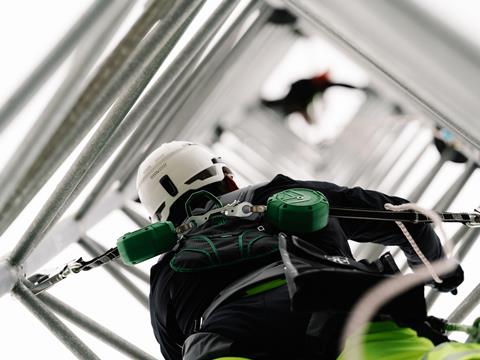
Final thoughts
Safe access and egress for workers is an important consideration throughout every phase of a building project, from design to construction and ongoing maintenance. With falls from height still being the leading cause of workplace fatalities in the UK, designers and architects are moving toward a proactive approach in order to eliminate risks and prioritise safety.
Safe access solutions can go beyond compliance with minimum standards. This includes evaluating potential hazards associated with access and egress, from ladder safety to permanent systems like stairways and platforms. Designers should consider incorporating fall protection measures such as guardrails, safety nets or personal fall arrest systems to help safeguard workers at all stages of the building’s lifecycle. Workers should train and become competent in the knowledge and skills necessary to use access systems safely.
One of the most important aspects is integrating safe access solutions into the building design from the outset. Permanent access points should be considered, reducing the reliance on temporary systems such as ladders, which carry inherent risks. Designing buildings with maintenance in mind helps workers safely access areas for inspection, cleaning and repairs long after construction is complete. By thinking holistically and considering both short-term and long-term safety, designers can embed height safety in the building’s design, reducing the need for costly, reactive adjustments later on.
As an industry, we can strive for innovation and implement best practices to protect workers at height. By embracing a safety-first mindset and integrating comprehensive safety strategies into the design, construction and maintenance phases, we can make significant strides in improving height safety and reducing the number of workplace fatalities in the UK.
For more information on best practices and solutions for safe access and egress, please contact MSA Safety.
Please fill out the form below to complete the module and receive your certificate.








